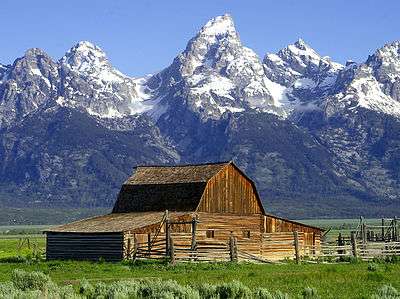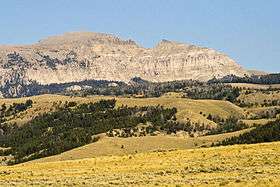Jackson Hole




Jackson Hole is a valley between the Teton Mountain Range and the Gros Ventre Range in Wyoming sitting near the border of Idaho. The term "hole" was used by early trappers or mountain men, who primarily entered the valley from the north and east and had to descend along relatively steep slopes, giving the sensation of entering a hole. These low-lying valleys surrounded by mountains and containing rivers and streams are good habitat for beaver and other fur-bearing animals.
History
The town of Jackson was named in late 1893 by Margaret Simpson, who at the time was receiving mail at her home as there was no post office. She named the town in order for easterners to be able to forward mail west. Jackson, which became incorporated in 1914, was named after David Edward "Davey" Jackson who trapped beaver in the area in the late 1820s while a partner in the firm of Smith, Jackson & Sublette.[1] Davy Jackson was one of the first European Americans to spend an entire winter in the valley of the Teton Mountains.[2]
Though used by Native Americans for hunting and ceremonial purposes, the valley was not known to harbor year-round human settlement prior to the 1870s. Descriptions of the valley and its features were recorded in the journals of John Colter, who had been a member of the Lewis and Clark Expedition. After returning to the Rocky Mountains, Colter entered the region in 1807 in the vicinity of Togwotee Pass and became the first European American to see the valley. His reports of the valley, the Teton Range and the Yellowstone region to the north were viewed by people of the day with skepticism.
The first people to settle the region were Native Americans, then fur trappers, and then homesteaders. Because the soil is not ideal for raising crops, the valley was used for cattle. Tourism quickly became popular with the establishment of dude ranches.
Settlements
The only incorporated town in the valley is Jackson, located at its southern end. Other communities in the valley include Wilson, Teton Village, Moran Junction, Hoback, Moose (Moose Wilson Road), and Kelly. West of Jackson, Teton Pass crosses the southern end of the Teton Range, providing access to Victor and Driggs in eastern Idaho and Alta, Wyoming, on the western side of the Tetons. This area was known as Pierre's Hole and hosted a major Rendezvous in 1832.
Numerous elk use the valley as grazing range during the winter, and sleigh rides are offered to tourists. The Jackson Hole Mountain Resort, Snow King and Grand Targhee Resort ski areas, and nearby Grand Teton and Yellowstone national parks are major tourist attractions throughout all seasons of the year.
Geography
The valley is formed by the Teton Range on the western side and the Gros Ventre Range on the eastern side. Grand Teton National Park occupies the north-western part of the valley encompassing much of the Teton Range as well as Jackson Lake. The town of Jackson is at the southern end. Between them lies, on U.S. Route 26, "Glacier View Turnout" offering a view of Teton Glacier on the north of Grand Teton,[3] and the National Elk Refuge, home of the largest elk herd on earth. The Snake River threads through the entire valley from its headwater in Yellowstone in the north to the mouth of the Snake River Canyon at the southern tip of the valley. Blacktail Butte is a prominent landform rising from the valley floor. The average elevation of the valley is over 6,500 feet (2,000 m) above sea level.
Climate
High altitude and steep mountain slopes on all sides of the valley often cause calm winter nights to be very cold, as radiational cooling from snow-covered ground creates cold air near the surface, which then slides down into the valley due to its higher density. In 1993, this effect during an already severe cold snap plunged the morning low temperature down to −56 °F (−49 °C) in the valley, officially recorded by the National Weather Service. The state record low temperature was also recorded in the valley at Moran at −66 °F (−54 °C) in 1933. Summers are warm to mild, due to the surrounding mountains.
Economy
Jackson Hole Airport is the largest and busiest commercial airport in Wyoming. Strict noise abatement regulations and the terminal building's low profile allow for the airport to operate within federal guidelines inside Grand Teton National Park. However, it becomes difficult to fly in the winter months. Major airlines serve the valley with jet service, some of which is seasonal (summer and winter).
The Federal Reserve Bank of Kansas City has hosted an annual economic policy symposium at Jackson Lake Lodge since 1982. They chose Jackson Hole in 1982 because of its trout fishing, as they were trying to attract Paul Volcker, who was Chairman of the Federal Reserve and a keen fly-fisherman.[4][5]
Jackson Hole was rated in 2017 as the best campsite in Wyoming in a 50-state survey conducted by Msn.com.[6]
Pop culture
Kanye West
From 2016 to 2018, Kanye West lived on a ranch in Jackson Hole while working on his album ye.[7] On May 30th, Kanye flew hundreds of reporters, musicians, political commentators, and more to Jackson Hole to hold a listening party as the album debuted. Additionally, the cover photograph for the album was taken just before the listening party and consists of the mountainous landscape surrounding West's land.[8] The image was quickly turned into an internet meme.[9]
Live Cam
In 2016, the Jackson Hole Tourism website put up 20 separate live screening web cams of the town in order to boost tourism. Since then, the audience of the live screening has grown rapidly, with some reports saying there may be 2000 people watching at any one time. [10][11][12]
Films
Jackson Hole has been the filming location for many films.
- The Big Trail (1930) – Starring John Wayne.
- The Big Sky (1952) – Starring Kirk Douglas.
- Shane (1954)[13]
- Spencer's Mountain (1963)
- Any Which Way You Can (1980) – Starring Clint Eastwood
- The Mountain Men (1980) – Starring Charlton Heston
- Rocky IV (1985) – Starring Sylvester Stallone and Dolph Lundgren
- Dances with Wolves (1990) – Starring Kevin Costner
- Django Unchained (2012) – A Quentin Tarantino film, starring Jamie Foxx and Leonardo DiCaprio
 Jackson Square
Jackson Square.jpg) National Elk Refuge
National Elk Refuge Teton Range
Teton Range
See also
Notes
- ↑ Hays, Carl D. W. (1983). "David E. Jackson". In Leroy R. Hafen. Trappers of the Far West: Sixteen Biographical Sketches. Lincoln: University of Nebraska Press. pp. 80–81. ISBN 0-8032-7218-9. originally published in Leroy R. Hafen, ed. (1972). Mountain Men and Fur Traders of the Far West vol. IX. Glendale: The Arthur H Clark Company.
- ↑ Mattes, Merrill J. "Grand Teton NP/Yellowstone NP: Colter's Hell and Jackson's Hole (Chapter 6)". Colter's Hell and Jackson's Hole. Yellowstone Library and Museum Association, and Grand Teton Natural HIstory Association, in cooperation with National Park Service. Retrieved 22 May 2013.
- ↑ Grand Teton National Park Photographer's Map & Guide. Earthwalk Press. 2008. ISBN 978-0-915749-25-6.
- ↑ Zeitlin, Matthew (31 August 2012). "Summer camp for bankers". The Daily Beast. Retrieved 23 March 2013.
- ↑ Wiseman, Paul (30 August 2012). "Why world markets focus on tiny Jackson Hole, Wyo". USA Today. Retrieved 23 March 2013.
- ↑ "The best campsite in every state". Msn.com. Retrieved June 8, 2017.
- ↑ "Inside Kanye West's Wyoming Listening Party".
- ↑ "Kanye Shot His Own Album Cover Pic with His iPhone at the Last Minute". 2 June 2018.
- ↑ "Kanye West Shares ye Album Cover Generator - Pitchfork". pitchfork.com.
- ↑ "Confession: I'm addicted to the goofily charming Jackson Hole webcam".
- ↑ "Jackson Hole Tourism website".
- ↑ "Why are thousands of people watching this live stream of a random town in Wyoming? Internet obsesses over Jackson Hole".
- ↑ Maddrey, Joseph (2016). The Quick, the Dead and the Revived: The Many Lives of the Western Film. McFarland. Page 184. ISBN 9781476625492.
References
- Daugherty, John. "A Place Called Jackson Hole". Grand Teton Natural History Association. Retrieved 2006-10-06.
- "The Mystery of the Colter Stone". Grand Teton National Park. Retrieved 2009-10-01.